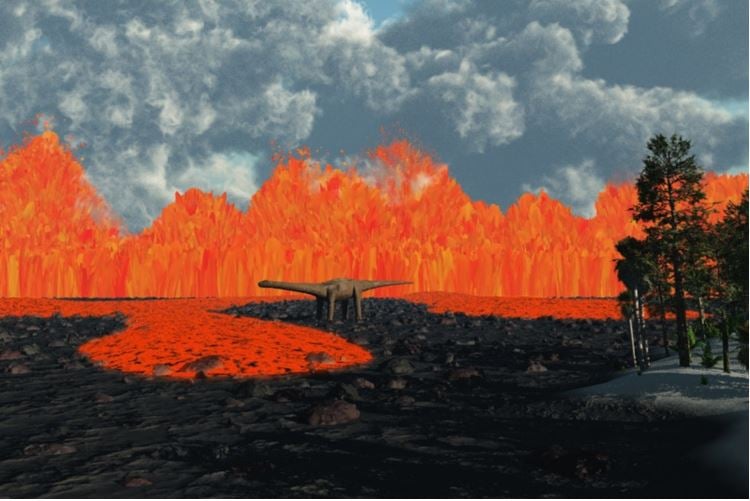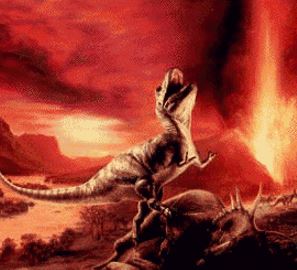Volcanic activity was not a major factor contributing to the extinction of dinosaurs and thousands of other species during the mass extinction in the Earth’s early history, says a new study led by the University of Leeds.
Impacts from asteroids and long-lasting volcanic eruptions, known as continental flood basalts – believed to be the two main causes of mass extinction events – would have propelled dust and gas into the atmosphere and significantly altered the climate for years.
Until now, however, nobody knew what the impact of several years of sulphur dioxide emissions from continental flood basalts was.
 Continental flood basalts had a less severe impact on the dinosaurs and other species than had previously been suggested. (Image: University of Leeds)
Continental flood basalts had a less severe impact on the dinosaurs and other species than had previously been suggested. (Image: University of Leeds)
A team of scientists explained in the academic journal Nature Geoscience that they have provided for the first time a quantitative estimate of the scale and nature of the effects that such eruptions had on our planet’s climate, oceans and vegetation.
Continental flood basalts not like today’s volcanic eruptions
Team leader, Dr. Anja Schmidt, who works at the University of Leeds’ School of Earth and Environment, said:
“At the time when the dinosaurs reigned, numerous long-lasting eruptions took place over the course of about a million years. These eruptions, called ‘continental flood basalts’ were not like volcanic eruptions we often see today, with lava gushing from the ground like a curtain of fire.”
“Each eruption is likely to have lasted years, even decades, and eruptions were separated by periods without volcanic activity. The lava produced by an eruption of average intensity would have filled 150 Olympic-size swimming pools per minute.”
Effects of flood basalts were less severe than thought
In this latest study, the scientists used a sophisticated computer simulation of the spread of aerosol particles and gas, which showed that the climatic effects of flood basalts were less severe than researchers had previously suggested.
Dr. Schmidt and colleagues found that only if such flood basalts had continued to ooze for hundreds of years non-stop, could the climatic impacts have been severe enough to affect the survival of plants and animals.
The team used data on the duration and intensity of continental flood basalt eruptions, including the Deccan Traps eruptions that occurred 65 million years ago, which covered one third of what today is India, to estimate the environmental and climatic effects of the massive quantities of sulphur dioxide gas emitted by those eruptions.
 So, was the dinosaur’s demise caused just by the large asteroid that hit Earth 65 million years ago and created the huge Chicxulub crater on the Yucatan Peninsula in Mexico?
So, was the dinosaur’s demise caused just by the large asteroid that hit Earth 65 million years ago and created the huge Chicxulub crater on the Yucatan Peninsula in Mexico?
According to their computer simulation, temperatures on Earth were indeed cooler as a result of volcanic activity – by as much as 4.5°C – but that the temperature would return to normal within half a century after an eruption ceased.
Dr. Schmidt and team noted that their conclusions are based on the assumption that climate feedbacks were very similar then to those today.
Acid rain effect selective
Dr. Schmidt said:
“Perhaps most intriguingly, we found that the effects of acid rain on vegetation were rather selective. Vegetation in some but not all parts of the world would have died off, whereas in other areas the effects would have been negligible.”
The scientists believe their findings will challenge the earth sciences community as a whole to examine the causes of mass extinctions and the role of volcanism again.
Dr. Schmidt said:
“We now need to better understand how long both the individual eruptions and the periods without volcanic activity lasted.”
Citation: “Selective environmental stress from sulphur emitted by continental flood basalt eruptions,” Anja Schmidt, Richard A. Skeffington, Thorvaldur Thordarson, Stephen Self, Piers M. Forster, Alexandru Rap, Andy Ridgwell, David Fowler, Marjorie Wilson, Graham W. Mann, Paul B. Wignall & Kenneth S. Carslaw. Nature Geoscience (2015), 23 November, 2015. DOI: 10.1038/ngeo2588.

